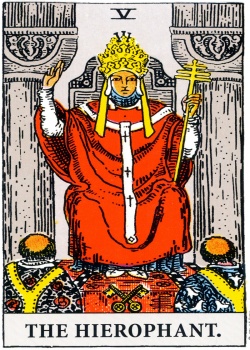Hierophant: Difference between revisions
No edit summary |
No edit summary |
||
| Line 1: | Line 1: | ||
<blockquote class="definition">The '''Hierohant''' is an [[Old Energy Archetype]] from the [[Masonic Tarot Deck]]. In the [[Book of Slavery]], the archetype is typically used to reinforce elitism, and the idea that the secrets of power can only be shown to those properly formed through initiation.</blockquote> | <blockquote class="definition">The '''Hierohant''' is an [[Old Energy Archetype]] from the [[Masonic Tarot Deck]]. In the [[Book of Slavery]], the archetype is typically used to reinforce elitism, and the idea that the secrets of power can only be shown to those properly formed through initiation.</blockquote> | ||
[[File:hierophant.jpg|250px|center|Hierophant Tarot Card Freemason's Deck]] | |||
==List of Old Energy Archetypes== | ==List of Old Energy Archetypes== | ||
Revision as of 20:27, 26 Mayıs 2020
The Hierohant is an Old Energy Archetype from the Masonic Tarot Deck. In the Book of Slavery, the archetype is typically used to reinforce elitism, and the idea that the secrets of power can only be shown to those properly formed through initiation.
List of Old Energy Archetypes
Old Energy Archetypes > Chariot, Death (archetype), Duality, Hermit, Hierophant, High Priestess, Judgement, Justice, Star, Strength, Sun (archetype), Temperance, The Devil, The Emperor, The Empress, The Fool, The Hanged Man, The Lovers, The Magician, The Moon, The Tower, The Wheel of Fortune, The World (old energy)
Notes
BOP: An authority figure who teachers the worthy aspirant: "(The Pope, the supreme holder of the knowledge of the Initiated.) Without complete theoretical instruction no one can tackle the effective practice of the 'Royal Art'. To pass a 'Brother' one must be practised in the handling of tools and be ignorant of nothing in the rules of architecture. The 'workman' who has reached the light perceives the Brilliant Star and knows the significance of the letter G, for geometry must be familiar to him." [1]
"The same idea of Esoterism, of secret Instruction, reappears; but the Tuition is now practical and oral, it no longer requires a book (third idea)."[2]
Footnotes
- ↑ Oswald Wirth, Tarot of the Magicians: The Occult Symbols of the Major Arcana That Inspired Modern Tarot (San Francisco. CA: Weiser Books, 1990). p. 170.
- ↑ Papus, The Tarot of the Bohemians (Wilshire Book Co, 1978), https://sacred-texts.com/tarot/tob/index.htm.
